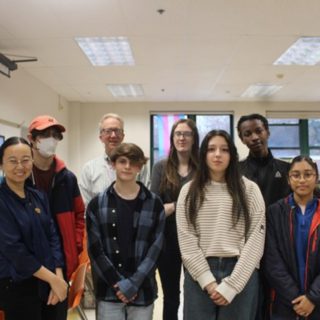ARHS InvenTeam aids local search and rescue

Every year, through the Lemelson-MIT program’s InvenTeams Grant initiative, schools from around the United States can apply for a $7,500 grant to invent a solution to a real-world problem.
In November 2023, ARHS was one of just eight schools in the country awarded a grant, and on February 11, the InvenTeam held its Mid-Grant Technical Review at Cherry Hill Cohousing to share progress of the project: a wearable base layer to monitor the location and vital signs of search and rescue (SAR) personnel.
According to the ARHS InvenTeam’s problem statement on the LMIT website, “The survival rate of a lost person decreases over time, so it is important that they are found as quickly as possible.”
If SAR personnel are lost or injured on an operation, and their peers at the command post are unaware of that, it becomes much harder to guarantee the safety of the person they’re searching for. “Many a time, the people who are trying to rescue others are the ones facing problems, and therefore the efficiency [of the operation] lowers,” said Yatharth Rajakumar ‘27, Main Tech Lead of the ARHS InvenTeam.
Many community members, including Amherst Fire Chief Tim Nelson, Representative Mindy Domb, and Town Manager Paul Bockelman attended the February 11 meeting to give suggestions on the design the InvenTeam had so far, and what they had planned going forward.
“We had three firefighters from the central command of the Amherst Fire Department, And they were able to give some really insightful feedback,” said William Larson ‘24, Communications Lead.
Collecting feedback is an integral part of the design process for the InvenTeam. When they were first awarded the grant, the InvenTeam had to choose one of two devices to invent: a drone, or a vital signs monitor.
Upon reaching out to Captain Steven Chandler of the Amherst Fire Department, and hearing his need for something easily portable with minimal setup required, the InvenTeam zeroed in on the vital signs monitor.
“Listening to his response to the question ‘I wish I had a,’ was really where the specific form of the invention came from. It came from listening to the stakeholders, the people whom we’re supporting. It’s really a form of empathy. Empathy is one of the most powerful design tools,” said John Fabel, physics and engineering teacher and InvenTeam advisor.
Before the InvenTeam got the grant, they were just “goofing around with gliders” in the Aerospace Club, until Fabel presented them with an opportunity from Lemelson-MIT. “We were like, ‘Sponsored by MIT? Yes, please.’ We applied for [the grant] over the summer, and then learned in October that we had been accepted for it,” said Larson.
At the end of the school year, all of the teams will convene at one big event called EurekaFest, and share their creations with each other and the general public.
The InvenTeam also received an invitation from State Rep. Mindy Domb to visit the Massachusetts Statehouse to meet the Legislature, which will be in session when the InvenTeam is at EurekaFest.
The grant does not include funds for everyone on the team to go to EurekaFest, so they are relying on crowdfunding to compensate for that. “We go to MIT, they let us visit and we look at all the other InvenTeams [from] around the country, look at what they made, and present our findings. That’s gonna be really cool,” said Cameron Baird, Software Tech Lead.
InvenTeam is much more than a grant or a device to its members, though. For many of them, it’s a way to apply engineering to the real world, beyond the constraints of a pencil and paper. “A group of high school students can achieve so much more than what people think,” said Rajakumar.














